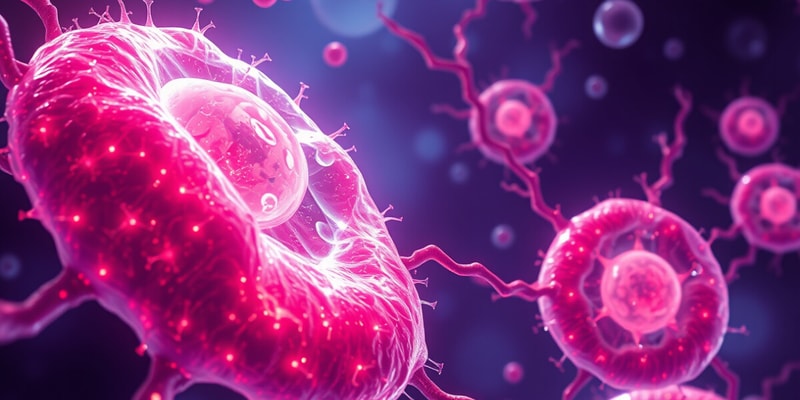Podcast
Questions and Answers
What are the two main characteristics of stem cells?
What are the two main characteristics of stem cells?
Which term best describes stem cells that can differentiate into cell types derived from all three embryonic germ layers?
Which term best describes stem cells that can differentiate into cell types derived from all three embryonic germ layers?
Which of the following is NOT a type of pluripotent stem cell?
Which of the following is NOT a type of pluripotent stem cell?
What is one criterion for maintaining pluripotency in embryonic stem cells?
What is one criterion for maintaining pluripotency in embryonic stem cells?
Signup and view all the answers
What role does Nanog play in stem cell pluripotency?
What role does Nanog play in stem cell pluripotency?
Signup and view all the answers
What is a common demonstration of pluripotency in vivo?
What is a common demonstration of pluripotency in vivo?
Signup and view all the answers
Which of the following factors is essential in maintaining embryonic stem cell pluripotency?
Which of the following factors is essential in maintaining embryonic stem cell pluripotency?
Signup and view all the answers
How does Sox2 function in embryonic stem cells?
How does Sox2 function in embryonic stem cells?
Signup and view all the answers
What signifies the immortality of pluripotent stem cells?
What signifies the immortality of pluripotent stem cells?
Signup and view all the answers
What is a feature of embryonic carcinoma cells?
What is a feature of embryonic carcinoma cells?
Signup and view all the answers
Which transcription factors are involved in the regulation of mouse embryonic stem cell proliferation?
Which transcription factors are involved in the regulation of mouse embryonic stem cell proliferation?
Signup and view all the answers
What role does Zic3 play in pluripotency regulation?
What role does Zic3 play in pluripotency regulation?
Signup and view all the answers
What changes occur in the cell nucleus during differentiation of ES cells?
What changes occur in the cell nucleus during differentiation of ES cells?
Signup and view all the answers
Which histone marks are associated with bivalent domains in the pluripotent epigenome?
Which histone marks are associated with bivalent domains in the pluripotent epigenome?
Signup and view all the answers
Which of the following best describes the chromatin status in pluripotent ES cells?
Which of the following best describes the chromatin status in pluripotent ES cells?
Signup and view all the answers
Which factors activate the cell cycle progression in mouse embryonic stem cells?
Which factors activate the cell cycle progression in mouse embryonic stem cells?
Signup and view all the answers
Which of the following is NOT a marker for endoderm lineage specification?
Which of the following is NOT a marker for endoderm lineage specification?
Signup and view all the answers
What characterizes the hyperdynamic nature of chromatin proteins in embryonic stem cells?
What characterizes the hyperdynamic nature of chromatin proteins in embryonic stem cells?
Signup and view all the answers
Which signaling pathway is primarily stimulated by Eras and Tcl1 to promote the cell cycle in mouse ES cells?
Which signaling pathway is primarily stimulated by Eras and Tcl1 to promote the cell cycle in mouse ES cells?
Signup and view all the answers
What is the direct role of Sox2 in mouse embryonic stem cells?
What is the direct role of Sox2 in mouse embryonic stem cells?
Signup and view all the answers
What is the primary function of Leukaemia inhibitory factor (LIF) in maintaining pluripotency?
What is the primary function of Leukaemia inhibitory factor (LIF) in maintaining pluripotency?
Signup and view all the answers
How does c-Myc contribute to stem cell signaling?
How does c-Myc contribute to stem cell signaling?
Signup and view all the answers
What happens to embryonic stem cells (ES cells) when LIF is absent?
What happens to embryonic stem cells (ES cells) when LIF is absent?
Signup and view all the answers
Which transcription factor is known for its dual role as an oncogene and tumor suppressor?
Which transcription factor is known for its dual role as an oncogene and tumor suppressor?
Signup and view all the answers
What is the result of c-Myc's interaction with GSK3b in the Wnt signaling pathway?
What is the result of c-Myc's interaction with GSK3b in the Wnt signaling pathway?
Signup and view all the answers
Which component is essential for the activation of Stat3 in teratogenic differentiation processes?
Which component is essential for the activation of Stat3 in teratogenic differentiation processes?
Signup and view all the answers
What is the main role of pluripotent cells in the mouse embryo?
What is the main role of pluripotent cells in the mouse embryo?
Signup and view all the answers
What overall effect does the overexpression of Klf4 have on embryonic stem cells?
What overall effect does the overexpression of Klf4 have on embryonic stem cells?
Signup and view all the answers
Which process is indicated by removing Oct3/4 and adding Cdx2 to ES cell culture?
Which process is indicated by removing Oct3/4 and adding Cdx2 to ES cell culture?
Signup and view all the answers
What factor is necessary for the maintenance of mouse embryonic stem cell pluripotency in vitro?
What factor is necessary for the maintenance of mouse embryonic stem cell pluripotency in vitro?
Signup and view all the answers
Study Notes
Pluripotency Stem Cells
-
Pluripotent stem cells are master cells with two important characteristics:
- Unspecialized cells capable of self-renewal
- Ability to differentiate into various cell types
-
These cells have different differentiation potentials, including:
- Totipotent
- Pluripotent
- Multipotent
- Unipotent
Pluripotent Stem Cells - Characteristics
- Derived from the Latin word "plures," meaning "several" or "many."
- Typically used to describe stem cells that generate cells from all three embryonic germ layers.
Pluripotent Stem Cell Types
- Embryonic stem cells
- Embryonic carcinoma cells
- Embryonic germ cells
- Induced pluripotent stem cells
Origins of Pluripotent Cells
- Embryonic carcinoma cells form teratomas.
- Abnormal karyotypes are common in embryonic carcinoma cells.
- Germline transmission is rare in these cells.
- Pluripotent cells originate from the inner cell mass (ICM) of a blastocyst.
Criteria for Pluripotency
- Immortality
- Undifferentiation
- Clonality
- Broad developmental potential
In Vitro Demonstration of Pluripotency
- Differentiation triggered when grown in suspension, forming embryoid bodies.
- Different cell types are spontaneously obtained.
- Specific growth factors direct ES cell differentiation.
In Vivo Demonstration of Pluripotency
- Teratoma formation when injected into a nude mouse.
- ES cells integrate, proliferate, and differentiate into germ lineages (including germ cells) when injected into a host blastocyst.
Regulation of Pluripotency in ES Cells
- Pluripotency is maintained by promoting proliferation and inhibiting differentiation.
Epigenetic Modifications and Pluripotency
- Epigenetic modifications regulate pluripotency.
- Transcription factors are involved in ES cell pluripotency.
Factors Required for Pluripotency
- Nanog
- Oct 3/4
- Sox 2
- LIF
- c-Myc
- Klf4
- Zic3
Core Regulatory Circuitry in ES Cells
- Core factors (Nanog, Sox2, Oct4) activate expression of target genes.
- Signaling components regulate pluripotency/self-renewal.
- Differentiation-promoting genes are regulated.
Nanog
- A transcription factor containing a homeobox domain.
- Downstream effects of signals from LIF and BMP.
- Elevated levels exclude LIF and feeder layer inclusion.
- Works with other key factors, including Oct4 and Sox2.
Oct 3/4
- A POU-domain transcription factor.
- Maintains pluripotency in ES, EGCs, and ECCs.
- Tightly regulated, associated with target genes for maintenance.
- Regulatory elements in target genes are close to Sox2 binding sites.
- Key factor in self-renewing stem cell framework.
Sox2
- Member of the HMG-domain DNA-binding family.
- Critical for embryonic development and preventing ES cell differentiation.
- Many ES cell pluripotency-associated genes are co-regulated by Sox2 and Oct3/4.
- Forms a ternary complex with Oct4/Oct1 and Fgf4 for function.
- Cooperates with other TFs (e.g., Nanog) to activate pluripotency markers.
LIF
- Interleukin-6 cytokine family member.
- Essential for maintaining pluripotency in vitro.
- Binds to a heterodimeric receptor (LIFR and gp130).
- Binding activates the JAK/STAT signal transduction pathway.
- Activated Stat3 maintains pluripotency.
Combinatorial Signaling Pathways
- LIF and master regulator genes are involved in maintaining mouse ESC pluripotency.
c-Myc
- Helix-loop-helix/leucine zipper transcription factor.
- Cellular function.
- Downstream effector of STAT3 in LIF receptor signaling pathway.
- A substrate for GSK3b in Wnt signaling pathway.
- Compensates for anti-proliferative effects of Klf4, especially in iPS cells.
Klf4
- Member of a quartet having a Kruppel-type zinc finger transcription factor.
- Can act as an oncogene and a tumor suppressor protein.
- Overexpression inhibits ES cell differentiation.
- Upregulates with Oct3/4.
- Role potentially limited to specific target genes.
- Represses p53, a negative regulator of Nanog.
Pluripotent Lineages in the Mouse Embryo
- Stages in mouse embryo development, showing lineages like germ cell, stem cell, etc.
Pluripotent Cell Formation in Mouse Blastocysts
- ICM forms pluripotent cells.
- Primitive endoderm forms on ICM's surface.
- Pluripotent cells become epiblast and proliferate.
- Form primitive ectoderm.
- Lineage restriction occurs.
- Lineage commitment to germ and somatic cells.
Differentiation of Mouse ES Cells
- Differentiates into three cell types (primitive endoderm, trophectoderm, primitive ectoderm).
- Mimics pluripotent stem cell differentiation in early embryos.
- LIF absence and Oct3/4 abundance promotes primitive endoderm cells.
- Nanog absence and Gata6 presence promotes parietal endoderm cells.
- Oct3/4 removal and Cdx2 addition encourages trophectoderm formation.
Regulation of Mouse ES Cell Proliferation
- Pluripotent transcription factors activate effectors for ES cell proliferation.
- Eras and Tcl1 stimulate PI3K/Akt signaling for cell cycle advancement.
- Other factors (b-Myb and c-Myc) directly promote cell cycle progression.
Transcriptional Regulation of Oct3/4
- Various factors (e.g., Sox2, Cdx2, Lrh1) regulate Oct3/4 expression.
Zic3
- Contributes to pluripotency maintenance by operating downstream from Oct4, Nanog, and Sox2.
- Inhibits endoderm lineage determination.
- The presence of Zic3 maintains homeodomain protein Nanog expression.
Epigenetic Regulations of ES Cells Pluripotency
- Changes in the nucleus and distribution of chromatan occur.
- Epigenetic changes accompany ES cell differentiation.
Characteristics of the Pluripotent Epigenome
- Nucleus shrinks; chromatan distribution shifts.
Studying That Suits You
Use AI to generate personalized quizzes and flashcards to suit your learning preferences.
Related Documents
Description
This quiz explores the characteristics and types of pluripotent stem cells, including their origins and differentiation potentials. It covers key terminology and essential concepts related to these master cells, suitable for students studying cell biology or regenerative medicine.



